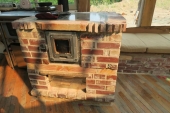posted 8 years ago
The path through the bells sounds fine, but the combustion is definitely not going to work the way you are hoping. If the clay at the feed is still damp enough to carve, I would suggest making the hole a couple of inches wider to give yourself some working room. Do you have any clay left over? Can you get perlite? I would advise taking some clay (sanded or not) and mixing it evenly with three or four times as much perlite by volume. This will make an insulative mix that can be formed into tubes or slabs. The perlite will create enough airspaces for water to escape from the clay without exploding.
I am going to describe a process assuming that your box with the feed hole is 8" high; adjust the proportions according to what it actually is.
Make a box 4" square by 12" long inside, with a 4" long lid for the middle third (kind of like a small shoebox). Set this in the hollow, with the center lid beneath the wall dividing the feed hole from the riser area.
Make a 4" square by 4" long open tube and set it on one end of the burn tunnel box, about where the feed hole is now. Carve out the feed hole as needed to fit the new tube. The top of the new feed tube should come to the top of your current feed surface more or less.
Make an approximately 4 1/2" diameter tube of perlite-clay, forming around something if you have it, as long as you can make it to sit on top of the other end of the burn tunnel and have a couple of inches of clearance below the top slab. Let this dry enough to stiffen up, then set it in place on top of the burn tunnel and seal the joint with a bit of clay. Add a few clay braces if you want to, to keep this heat riser tube from shifting inside the bigger square box.
Pour perlite into the hollows around the feed tube, burn tunnel and heat riser, at least halfway up the riser or more if you can.
This will make a well-insulated combustion chamber that will probably burn cleanly, and give you a good amount of heat for your bells.

 1
1




![Filename: Vulcan.jpg
Description: [Thumbnail for Vulcan.jpg]](/t/61323/a/46152/Vulcan.jpg)





































 1
1

































